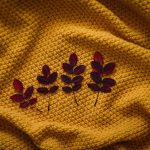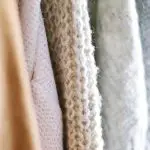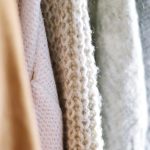Are you curious about whether denim is a knit or woven fabric? Look no further! In this article, we will delve into the characteristics of both knit and woven fabrics, as well as the weaving and knitting processes of denim.
By the end, you’ll have a clear understanding of the differences between knit and woven denim fabrics, allowing you to make informed decisions when it comes to your clothing choices.
So, let’s unravel the mystery together!
Table of Contents
Understanding Denim Fabric
Denim fabric is typically woven, giving it its distinctive texture and durability. Woven fabrics are created by interlacing warp and weft threads in a specific pattern. In the case of denim, the warp threads are dyed, creating the characteristic indigo color, while the weft threads remain white. This weaving technique results in a strong and sturdy fabric that is perfect for making jeans, jackets, and other durable clothing items.
One of the key properties of denim fabric is its strength. The tight weave of denim makes it resistant to tears and abrasion, ensuring that your denim garments will last for a long time. Additionally, denim fabric has excellent breathability, allowing air to pass through and keeping you comfortable even in hot weather.
When it comes to caring for denim fabric, there are a few important things to keep in mind. First, always read and follow the care instructions on the garment label. Most denim can be machine washed, but it’s best to turn the garment inside out to protect the color. Avoid using bleach or harsh detergents, as they can weaken the fabric and cause fading. Finally, air drying is recommended to preserve the shape and color of your denim garments.
Characteristics of Knit Fabrics
When it comes to characteristics, knit fabrics are known for their stretchiness and flexibility. They are made by interlocking loops of yarn, which gives them their unique properties.
One advantage of knit fabrics is their ability to stretch and conform to your body shape, making them comfortable to wear. They also have good draping qualities, allowing them to hang nicely and flow gracefully. Another advantage is that knit fabrics tend to be more breathable compared to woven fabrics, making them ideal for activewear or garments worn in warm weather.
However, knit fabrics do have some disadvantages. One disadvantage is that they are more prone to snagging and pilling. The loops in the fabric can easily catch on sharp objects or rough surfaces, leading to small tears or snags. Pilling occurs when the fabric forms small balls of fiber on the surface due to friction. Knit fabrics also have a tendency to stretch out over time, losing their original shape. This can be especially problematic in garments that require structure or a close fit.
Characteristics of Woven Fabrics
When it comes to understanding the differences between woven and knitted fabrics, it’s important to consider the construction methods used.
Woven fabrics are made by interlacing two sets of yarns at right angles, creating a stable and durable fabric.
On the other hand, knitted fabrics are created by interlocking loops of yarn, resulting in a more stretchy and flexible material.
Understanding these differences can help you choose the right fabric for your project and understand how patterns are created differently for each type of fabric.
Woven Vs. Knitted: Differences?
To understand the differences between woven and knitted fabrics, you need to consider factors like their construction and stretchability. Woven fabrics are made by interlacing two sets of yarns at right angles, creating a stable and structured fabric. On the other hand, knitted fabrics are made by interlooping a single thread, resulting in a more flexible and stretchy fabric. Here is a comparison table to illustrate the differences:
| Woven Fabrics | Knitted Fabrics |
|---|---|
| Structured and stable | Flexible and stretchy |
| Less stretchability | High stretchability |
| Durable and resistant to tearing | Prone to snagging and unraveling |
| Less comfortable | More comfortable and breathable |
While woven and knitted fabrics have their differences, they also share some similarities. Both are used in various applications, such as clothing, home textiles, and industrial uses. They offer different advantages, with woven fabrics being more durable and knitted fabrics providing more comfort and stretchability. Understanding these differences can help you choose the right fabric for your needs.
How Are Patterns Created?
If you want to create patterns on your clothing, you can use techniques like screen printing or block printing. These methods allow you to add unique designs and textures to your garments.
Here are three pattern-making techniques to consider:
-
Screen printing: This involves using a mesh screen to transfer ink onto the fabric. You can create intricate designs by blocking certain areas of the screen and applying different colors.
-
Block printing: With this technique, you carve a design onto a block of wood or linoleum. You then apply ink to the block and press it onto the fabric, transferring the design. This method is great for achieving bold and repetitive patterns.
-
Stencil printing: Stencils are a simple yet effective way to create patterns. You can cut out shapes or designs on a sheet of paper or plastic and then apply paint or ink over the stencil onto the fabric.
The Weaving Process of Denim
When it comes to denim fabric construction, understanding the concepts of warp and weft is essential.
The warp refers to the vertical threads running lengthwise in the fabric, while the weft refers to the horizontal threads running across.
In denim, these threads are woven together using a twill weave technique, creating the characteristic diagonal pattern that sets denim apart.
Denim Fabric Construction
Understanding denim fabric construction is important because it determines the durability and appearance of your jeans. Denim fabric is typically constructed using a twill weave, which gives it its characteristic diagonal pattern. This weave involves interlacing the warp and weft threads in a specific pattern, creating a strong and sturdy fabric.
The tight weave of denim makes it resistant to tearing and stretching, ensuring that your jeans will last a long time. Additionally, denim fabric has unique properties that make it a popular choice for jeans. It is known for its durability, breathability, and ability to fade beautifully over time.
These properties, combined with the construction of the fabric, contribute to the overall quality and style of your denim jeans.
Warp and Weft
Now that you understand the construction of denim fabric, let’s delve into the two main components: warp and weft.
The warp refers to the vertical threads in the fabric, while the weft refers to the horizontal ones. The warp threads are tightly stretched over the loom and are responsible for providing the fabric’s strength and stability. They are woven together using a technique called warp weaving, where each warp thread passes over and under the weft threads.
On the other hand, the weft threads are inserted horizontally through the warp threads using a process called weft knitting. This creates the distinctive diagonal pattern known as the twill weave, which is characteristic of denim fabric.
Understanding the interplay between the warp and weft is crucial in creating the durable and versatile fabric we know as denim.
Twill Weave Technique
The twill weave technique creates the distinctive diagonal pattern found in denim. In this weave, the weft threads pass over one or more warp threads before going under one or more, creating a diagonal line. This diagonal pattern is what gives denim its unique look and durability.
The twill weave technique is commonly used in denim fabric construction because it produces a sturdy and long-lasting fabric. The diagonal pattern also helps with flexibility and comfort, making denim a popular choice for jeans and other clothing items.
Additionally, the twill weave allows for the fabric to be dyed easily, resulting in the iconic indigo color commonly associated with denim.
The Knitting Process of Denim
During the knitting process, denim fabric is formed by interlocking yarns together. This technique allows for the creation of a sturdy and durable fabric that is commonly used in the production of jeans and other denim garments.
Here are four key aspects of the knitting process that contribute to the unique characteristics of denim:
-
Knitting Techniques: There are different knitting techniques used to create denim fabric, including weft knitting and warp knitting. Weft knitting involves interlocking yarns horizontally, while warp knitting interlocks yarns vertically. These techniques result in different textures and appearances in the final fabric.
-
Types of Knitting Needles: The choice of knitting needles also plays a role in the knitting process of denim. Different needle sizes and materials can affect the tension and thickness of the fabric. For denim, larger and sturdier needles are often used to create a dense and durable fabric.
-
Yarn Selection: The type of yarn used in the knitting process greatly influences the quality and characteristics of denim fabric. Traditionally, denim is made from cotton yarn, which offers strength, breathability, and comfort. However, other blends and synthetic yarns are also used to enhance the fabric’s performance and stretchability.
-
Finishing Techniques: Once the knitting process is complete, denim fabric undergoes various finishing techniques such as washing, dyeing, and distressing to achieve the desired color, texture, and appearance. These techniques give denim its signature worn-in and faded look.
Comparing Knit and Woven Denim Fabrics
When comparing knit and woven denim, one key difference is the way the yarns are interlocked to create the fabric. Knit denim is made using a knitting process, where yarns are looped together to form a series of interconnected loops. This results in a fabric that has more stretch and flexibility compared to woven denim. On the other hand, woven denim is created by weaving horizontal and vertical yarns together in an over-under pattern, creating a sturdy and durable fabric.
To further understand the differences between knit and woven denim, let’s compare them in terms of stretch, texture, and appearance:
| Comparison | Knit Denim | Woven Denim |
|---|---|---|
| Stretch | Has more stretch due to the knitting process | Less stretch compared to knit denim |
| Texture | Typically softer and smoother texture | Often has a more rigid and textured feel |
| Appearance | Often has a more even and uniform look | Can have a more varied and textured appearance |
In addition to these differences, it’s important to note that both knit and woven denim can come in different types of washes, such as distressed, acid wash, or stone wash. These washes add different effects and finishes to the denim fabric, allowing for a wide range of styles and looks to choose from.
Conclusion
In conclusion, denim is a woven fabric, not a knit fabric. Woven fabrics are made by interlacing yarns at right angles, creating a stable and durable material. Denim specifically undergoes a unique weaving process called twill weave, which gives it its characteristic diagonal ribbing.
While knit fabrics are made by interlooping yarns, resulting in a stretchy and flexible material. Understanding the differences between knit and woven fabrics is essential in choosing the right fabric for different projects or clothing items.
- Tetron Fabric for Marine Applications: Durability and Use Cases - June 18, 2025
- Tetron Fabric for Outdoor Furniture: Weather Resistance and Care - June 18, 2025
- Tetron Fabric for Wall Coverings: Style and Application Tips - June 18, 2025




